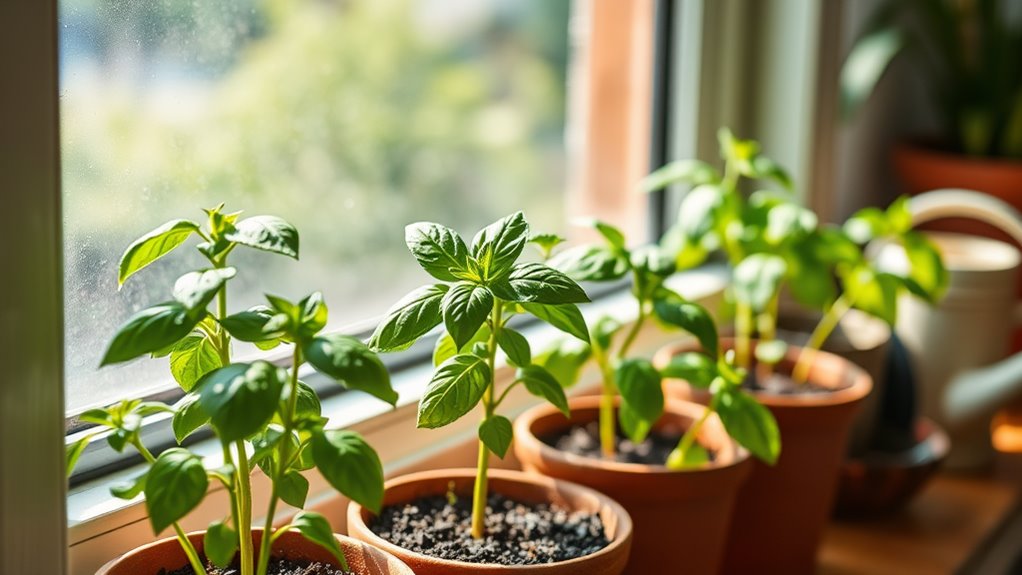The Easiest Way to Grow Herbs Even If You’ve Never Gardened Before
If you’re new to gardening, start with easy herbs like basil or mint—they’re tough and forgiving. Grab simple supplies: pots, nutrient-rich soil, and seeds or seedlings. Pick a sunny spot with good drainage, loosen the soil, mix in compost, and plant your herbs. Water when the top inch feels dry, using a can for even moisture, and avoid overwatering. You’ll soon harvest fresh flavors, with plenty more steps to master your green thumb.
Choosing Beginner-Friendly Herbs
How do you pick beginner-friendly herbs that thrive with little fuss?
In herb gardening for beginners, focus on resilient choices like basil, which matures quickly and tolerates errors, mint that spreads vigorously with minimal water, thyme for its drought resistance, and rosemary for hardy growth. Additionally, consider the importance of soil selection, as it plays a significant role in the success of your herb garden. You’ll select these based on your climate and space; they adapt easily, yielding fresh flavors through simple care and steady harvests.
Gathering Basic Supplies
Once you’ve chosen your herbs, start by gathering the essential supplies that guarantee a smooth start to your garden. You’ll need pots for containment, quality soil mix for nutrients, seeds or seedlings for planting, and a watering can for hydration. These items assure success without hassle. Additionally, consider using container gardening techniques to maximize your growing space and enhance your herb garden’s productivity.
| Supply | Purpose |
|---|---|
| Pots | Supports root growth |
| Soil mix | Provides key nutrients |
| Seeds/Seedlings | Initiates herb growth |
| Watering can | Enables even watering |
Preparing Your Planting Space
With your supplies in hand, you’ll need to choose and set up an ideal planting space to make sure your herbs flourish.
Select a spot with at least six hours of sunlight daily, ensuring good drainage to prevent root rot. For indoors, use a sunny windowsill with pots; outdoors, prepare well-aerated soil by loosening it and removing weeds for best growth. Additionally, consider using beginner-friendly herbs such as basil or mint, which are known to thrive indoors and are great for novice gardeners.
Planting Your Herbs Step by Step
Now it’s time to select the right seeds for your herbs, choosing varieties that match your local climate and growing conditions for ideal results. You’ll then prepare the soil by loosening it to a depth of about 6 inches and mixing in compost to make sure it’s nutrient-rich and well-drained. Additionally, consider using herbs that thrive indoors to ensure success in your kitchen garden. With these steps in place, you’re set to plant effectively and watch your herbs thrive.
Select Seeds
Choosing the right seeds sets the foundation for a thriving herb garden, so focus on varieties that match your local climate and space. When picking seeds, check packet details for growth habits and disease resistance to guarantee success. You’ll select healthier options by considering these factors.
| Herb | Recommended Variety |
|---|---|
| Basil | Genovese (fast-growing) |
| Mint | Spearmint (vigorous spread) |
| Rosemary | Arp (drought-tolerant) |
| Thyme | English (compact) |
| Cilantro | Santo (bolt-resistant) |
This guide helps you choose wisely for a bountiful harvest.
Prepare Soil
Properly preparing your soil guarantees your herbs thrive, so begin by testing its pH and texture to match each plant’s needs.
Use a reliable test kit for accuracy, then adjust pH with lime if acidic or sulfur if alkaline.
Mix in compost to boost fertility and drainage, breaking up clumps for even consistency.
Make sure the bed is weed-free and moist, setting the stage for robust herb growth.
Maintaining and Watering Your Garden
Maintaining your herb garden involves regular watering and upkeep to promote healthy growth.
You’ll check soil moisture daily by inserting a finger an inch deep; water deeply if it’s dry, using a can for even distribution.
Most herbs thrive with moderate moisture, so avoid overwatering to prevent root rot.
Mulch around plants to retain water and control weeds, ensuring consistent health. Additionally, many easy-to-grow herbs such as basil and parsley can flourish in small spaces, making them ideal for beginners.
Harvesting and Using Your Herbs
Once your herbs have flourished through proper maintenance, you’ll enthusiastically harvest them to savor their peak flavors and promote ongoing growth.
Snip leaves just above growth nodes using sharp scissors for bushier plants; do this in the morning to preserve essential oils.
Dry herbs by hanging in a ventilated, dark space, then store in airtight containers.
Experiment with fresh herbs in recipes like pesto or teas for enhanced taste and health benefits.

